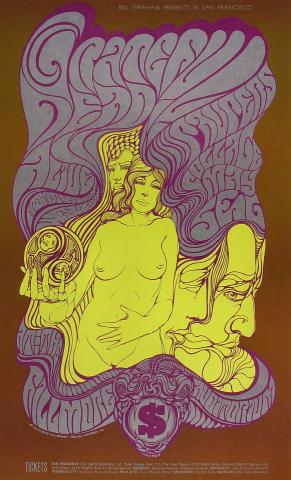Grateful Dead Poster

Image may not exactly match item shipped.
BG062 is Wes Wilson's final Fillmore poster in his series of 56 and is a study in symbolism. Wilson's comments on the future of the counter-culture movement and his view of the predation of concert promoters are more subtle. Wilson casts a jaded eye on the avarice of the industry in general and Bill Graham in particular and brands the Fillmore banner at the bottom of the poster with a vaguely Christian symbol featuring the Almighty Dollar.
1st printing A (see BG062-1) utilized the "split fountain technique", which tapers the ink from green at the top of the poster to pink at the bottom. This original, pre-concert printing measures 14 1/16" x 24".
1st printing B omits color from the poster, instead displaying a black and white image. It was printed before the concert and measures 14 1/16" x 24".
The pre-concert 1st printing C incorporates yellow ink into the split fountain, so the poster ranges from a greenish yellow into a medium yellow down into a pink color at the bottom. It measures 14 1/8" x 24".
The post-concert 2nd printing has a brown background, yellow figures and silver lettering, matching the 2nd printing postcard. It measures 14" x 22 11/16".
The 3rd printing (see BG062-1) is on glossy cover stock and bears the notation "Wolfgang's Vault" in the lower right hand margin. It was printed in 2014 by the Bill Graham Archives LLC in a 500 copy run and measures 20 3/8" x 34 1/8".
The 4th printing is on #80 matte cover stock. It resembles the 2nd printing and has "W 2021" in the lower right-hand margin. It was printed in 2021 by Wolfgang's in a 100 copy run. This reprint measures 14" x 23".
When the Avalon Ballroom and Bill Graham's Fillmore Auditorium began to hold weekly dance concerts, Wilson was called upon to design the posters. He created psychedelic posters from February 1966 to May 1967, when disputes over money severed his connection with Graham. Wilson pioneered the psychedelic rock poster. Intended for a particular audience, "one that was tuned in to the psychedelic experience," his art, and especially the exaggerated freehand lettering, emerged from Wilson's own involvement with that experience and the psychedelic art of light shows.